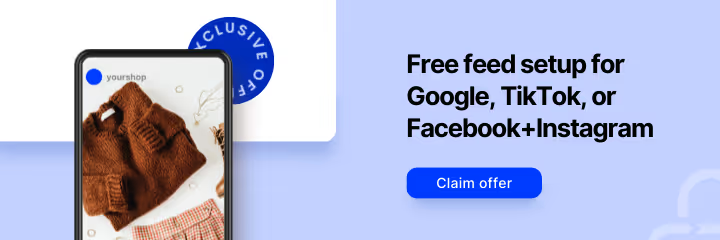One of the best things about selling online is that anyone can do it. Stories of overnight success aside, this can create a false sense of security for the rest of us.
Yes, anyone can find success selling online — under the right circumstances. Unfortunately there’s a lot of outdated, misleading, and outright incorrect advice out there. Follow enough bad advice and your business can suffer. That’s why we’re here to set the record straight.
Here are 11 misconceptions about ecommerce you should immediately cast aside.
Ecommerce myth 1: If your sales are fine, you don’t need to diversify marketing channels.

In the ecommerce world, changes happen almost instantly. Any marketer who was using cookies to target Facebook audiences can attest to this unnerving fact. Multi-channel marketing doesn’t just help you boost sales, but it helps you avoid disaster. Like, for example, when one channel’s audiences disappear.
By implementing a multichannel marketing strategy, you can seamlessly transition your sales focus without disrupting revenue flow.
Ecommerce myth 2: Multichannel marketing is too difficult.
This one’s partly true. Multichannel marketing can be in fact be difficult.
Especially when you’re tackling business tasks all by yourself, the technical side of formatting product data, sourcing content, connecting to channels, and monitoring channel feeds can be very difficult and very time-consuming. They don’t have to be, though. More than 2,400 merchants and marketers rely on GoDataFeed to automate the most challenging parts of multichannel integration.
GoDataFeed’s smart catalog consolidates and standardizes product data regardless of source(s), simplifies channel integration, optimizes feed attributes, and automatically syndicates feed delivery for you, the processes are all automated, so there’s no steep learning curve or frustrating trial and error sessions.
Ecommerce myth 3: You can’t succeed because competitors have much bigger.

The ability to outspend competitors is a nice luxury to have. If that’s how you roll, good for you. But if you’re like the rest of us, you must be smart about your budget.
Luckily, digital marketing channels like Google have systems in place to balance things out. That’s where data quality comes in. Thanks to their algorithmic magic, data quality can help level the playing field, especially on major marketing channels like Google.
High quality data and richer product profiles translate to channel listings that attract and inform, giving users the “full view” of your products.
Ecommerce myth 4: Buyers only care about one thing: price.
Price may be the primary concern for some shoppers, but most consider a variety of factors when purchasing online. These include aspects of the user experience, such as convenience, personalization, and flexibility. Some consumers even consider a company’s community involvement, sustainability, and social responsibility before making a choice.
That’s not to say your price should not be competitive. That’s a must. But if you find that your prices just can’t compete because your products are higher quality, you’ve got to find another way to make your listings stand out.
Differentiate your brand by highlighting your products superior features, your customer service, your customers’ trust, your team’s expertise, your store’s selection, and/or the convenience of shopping from you.
Savvy marketers find ways to inject differentiators as supplementary data (i.e., data not usually part of your product listings) into their listings. “Optimized” product listings — even those at higher price points — routinely outperform thin, incomplete product listings.
Ecommerce myth 5: Now is just not the time to make changes to your marketing strategy.
At certain times of the year, particularly the holiday season, many sellers go into “code freeze” to eliminate tech hiccups during peak visitor times. Fortunately, there is a way to connect to new channels without altering code or product data. GoDataFeed takes on all the “heavy lifting” of safely connecting to channels. And because GoDataFeed acts like a content management system (CMS) for your product data, no changes are made to your original source data.
That means you can jump on new channels quickly, effectively, and safely, without affecting current systems, strategies, or campaigns.
Ecommerce myth 6: Build it, and they will come.

Ah, the Field of Dreams Fallacy….
Even if you haven’t seen Kevin Costner’s The Field of Dreams, you have probably heard and internalized that movie’s most famous tagline: “If you build it, they will come.”
This translates to retail as: “If I open a great store and sell products that people want, I can’t help but be successful!”
Unfortunately, that’s just not true. It’s difficult to pin down exactly what percentage of online stores fail. Some say about 80 percent die out within the first two years. Others put the number much higher – a horrifying 97%. Even if your product’s value prop is airtight, there’s no guarantee it’ll sell.
But why?
Because even if your value proposition is stellar, you still have to get your products in front of the right customers. Unless you are the only business selling a particularly popular product, leaving your customer acquisition to chance is not a strategy for success.
Ecommerce myth 7: $5 a day on Facebook ads is “good enough.”
This simply isn’t true. The average cost per click across all categories on Facebook is $1.72. At that cost, you’d be lucky to get 2-3 visitors a day. That’s just not enough to sustain an ecommerce business.
Succeeding with Facebook Dynamic Product Ads and Facebook Shops requires extensive testing across dozens of data points and with multiple creatives. Spending $5 a day doesn’t give you nearly enough information to make the right targeting and creative decisions.
Ecommerce myth 8: People are clicking and buying already. You don’t need to map a customer journey.
Back in the Gold Rush days of the Internet, this might’ve been true. Today, fewer than 4% of customers buy from a site immediately after clicking on an ad. Most will simply leave and never come back — unless you give them a reason to.
A well-designed customer journey helps educate shoppers on the benefits of your products, build desire for your products, and distance competitor products for the 96% of folks who don’t buy immediately.
Ecommerce myth 9: A focus on AOV, not ROI.
Let’s look at a hypothetical example from Shopify:
“If your store has a total revenue of $2,000 split between 100 orders, your [AOV] is $20. This means that, on average, a customer spends $20 for each purchase from your store. Traditionally, businesses that know their AOV is $20 focus on getting customers to spend past that threshold, e.g., a free shipping offer applied at $25. And while that can help your revenue stream, it may not bring you the highest profit margins.”
Shopify recommends changing how you think about AOV. If higher average order value and lower costs of acquisition equal positive ROI, you should also focus on reducing acquisition costs.
To reduce costs of acquisition, we recommend implementing the following:
- Campaign KPI monitoring
- A/B testing
- Product feed optimization
- Channel diversification
Ecommerce myth 10: If you spent a lot of money on current solutions, you can’t change now.
This is called the fallacy of sunk costs. It happens when people and businesses spend large amounts of money on solutions that end up delivering little or no results. Because they’ve invested their time and money into the solution, they want it to work — even if it’s not the right fit for their business goals.
It’s hard to admit when it’s time to “cut your losses,” but embracing the right solution can help you course-correct and potentially save you from even greater loss.
Ecommerce myth 11: My website is perfect.
Your website or brand page is often the central hub of your online business. It’s very likely where your customers form first impressions about your business.
That’s why it’s important to continually test elements for conversion optimization. But what should you test?
Conversion optimization deserves its own conversation. Bigcommerce’s Conversion Rate Optimization strategy includes 30+ factors that can be split-tested and measured side-by-side. These range from on-page elements like visuals and copywriting to channel listing elements like product titles and promotions.
The truth is…
The path to ecommerce success is different for everyone. But regardless of your strategy, you’ll want to focus your team’s efforts on tasks that move the needle. You’ll also want to make sure your team has the tools to get the job done. The less resources you have in-house, the more you’ll need to invest in finding the right toolset.
Solutions like GoDataFeed can cost-effectively empower your team to dramatically improve online sales while automating processes to save you time and effort.





%20).webp)